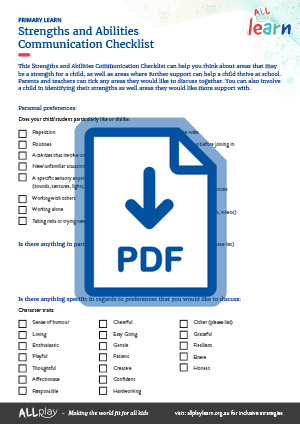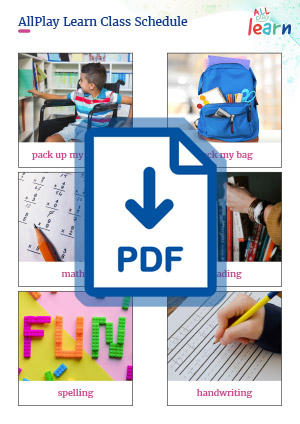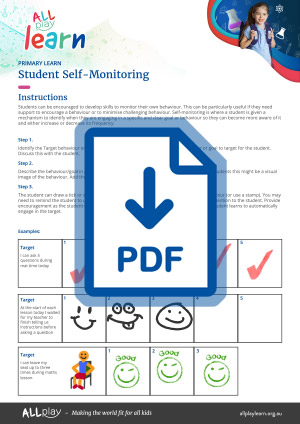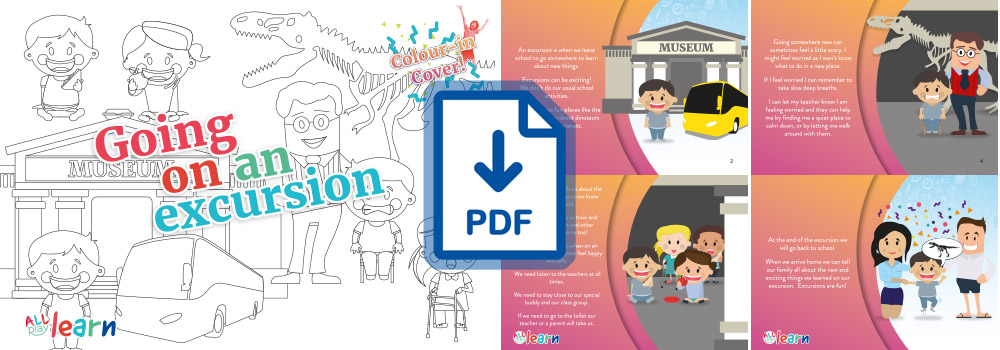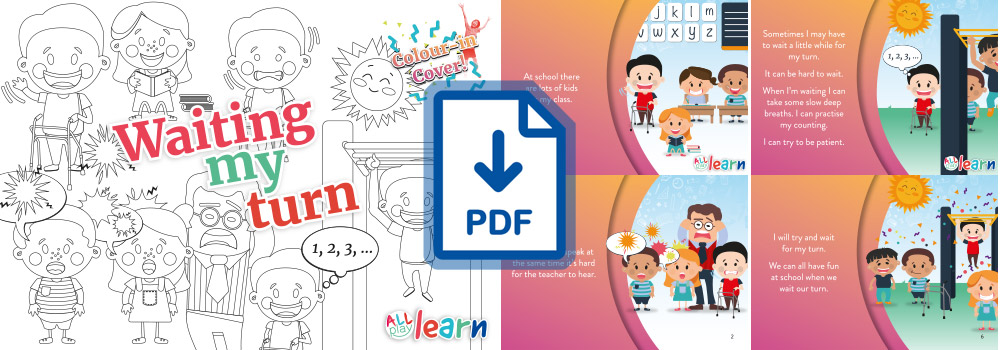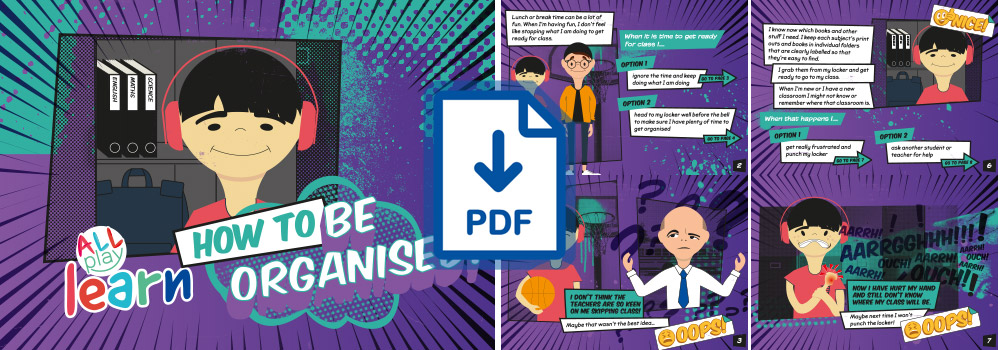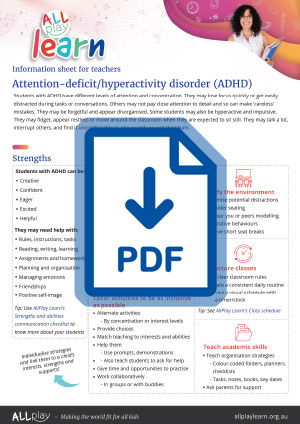
Attention-deficit/hyperactivity disorder (ADHD)
On this page:

About attention-deficit/hyperactivity disorder (ADHD)
Students with ADHD have different levels of attention, concentration, impulse-control and energy. While all students can have times where they struggle to focus or sit still, students with ADHD tend to experience this more frequently and significantly.
While ADHD can look different from one student to another, students with ADHD typically experience differences in one or more of these areas:
- Attention. They may lose focus when doing tasks or listening to their teachers speak. It can seem like their mind is elsewhere. It may appear that they don’t listen to instructions, or they may get easily distracted part way through a task. They may not pay close attention to detail and so can make ‘careless’ mistakes. Strategies that help reduce distractions, focus a student’s attention, or help them to stay on task are most relevant.
- Hyperactivity. Some students with ADHD may talk a lot, and find it uncomfortable to play quietly. They may fidget, appear restless, or become bored quickly. Some students may move around the classroom when they are expected to sit still. They may enjoy movement-based, active or hands-on activities that allow them to move or tap into their high activity levels.
- Impulsivity. Some students may act without thinking. This might mean they interrupt others, blurt out answers, or they may not wait their turn. Some students may take risks, or rush ahead without waiting for permission. They may have intense emotional reactions. Sometimes, these characteristics can make group work challenging and can impact a student’s friendships with others. Strategies that reduce distractions, and support regulation of emotions, behaviour and social interactions can help.
- Organisation, time management and planning. Some students may need support to acquire organisational skills. For example, they may lose track of their belongings and homework, and they may need support with task initiation (getting started on a task) or completing a task within a set period of time. Strategies that teach students skills to support organisation, time-management and planning can be helpful.
Some students with ADHD may have learned to 'mask' (hide or camoflage) their ADHD characteristics, which can have a negative impact on their wellbeing. Learn more about what masking may look like, and tips on how to support a student who is masking, in this brief overview.

Strengths
What might be some strengths?
- Students with ADHD may have similar thinking and communication skills to other students.
- They may show creativity, such as coming up with more imaginative ideas or thinking 'outside the box'.
- Some have strong feelings of self-competence. They may become quite good at overcoming obstacles.
- Some students with ADHD may be good at doing what their teacher asks. A student may be able to answer back eagerly or help out with tasks quickly.
- Some students with ADHD may be excited to learn new things and be more involved in their learning. They may be more willing to raise their hand and ask relevant questions.
Where might you provide support?
- Students with ADHD may sometimes look like they are ‘daydreaming’. It may appear that they are not interested in the activity. They may not respond straight away when their name is called.
- Some students may find extra support and time helpful as they read, write, do maths and learn new information.
- Give lots of guidance with assignments and homework. They may forget to write homework down or work on it at home. They may also lose worksheets or bring the wrong books and papers to class. They may not hand in finished homework on time.
- Sitting still at their desks for long periods of time can be uncomfortable. They may call out, fidget, leave their seats or talk to their classmates.
- They may need support to manage their emotions. Their relationships with other kids and teachers can be affected if they forget to follow rules or take turns.
- All these areas can affect how students with ADHD view themselves. They may need support and encouragement to help them feel positive about themselves.

Evidence-based strategies
Consider how you communicate
Modify the environment
Structure classes
Tailor activities to be as inclusive as possible
Provide feedback
Support students to self-manage
Teach academic skills
- Get their attention before speaking. Eye contact, gestures, touch or verbal prompts can be used to get children’s full attention before giving instructions or speaking to them.
- Speak clearly. Give clear and direct instructions about the task, the behaviour expected, and how much time children have. These instructions may need to be repeated at the start of each new task.
- Simplify instructions and learning. Consider breaking down big tasks into smaller ones. For example, give step-by-step instructions or visual instructions (i.e. pictures). It may be helpful to check their understanding before moving on to the next step or activity. For example, ask them to repeat instructions or answer questions.
- Vary teaching formats. Consider using pictures, videos, PowerPoint presentation, objects, or demonstrations to explain concepts and tasks. Hands-on lessons can be very engaging.
- Use computer software. Multimedia educational software on the computer or tablet may help some students focus on complex lessons, such as mathematics or reading. Interactive software where students can answer questions and receive immediate feedback are good for practising these skills.
- Consider read-aloud accommodations during testing. Presenting the items of a test orally can assist in focusing students’ attention and increasing engagement during testing.
- Minimise potential distractions. It may be helpful to sit children with their backs facing windows, doors, corridors or other busy areas of the classroom. Distractions could be removed when not in use.
- Consider seating. Consider sitting children near friends who can model positive behaviours, or close to you so you can interact with them. Short seat breaks (e.g. run an errand, touch their toes) may improve focus and restlessness.
- Set clear classroom rules. A few short and simple rules that are reviewed regularly may be best. Teach them at the start of the school year, verbally and with the help of pictures. Children may respond well to rules that tell them what to do rather than what to avoid. Rules could be displayed where all students can see them.
- Create a consistent daily routine. Rules and routines help a child know what is planned for the day so that they know what to do if they have missed instructions. Consider using a daily visual schedule with a timer/clock that students can see at all times. Access AllPlay Learn’s class schedule in relevant resources.
- Alternate activities. Consider giving tasks that require higher concentration earlier in the day. Mixing high- and low- interest activities throughout the day may help keep them interested. Breaks after finishing each small task may help with their attention.
- Provide choices. Giving students choices in their work can increase engagement. Consider letting them write, draw, point to cue cards, demonstrate or talk to demonstrate their learning.
- Match teaching to interests and abilities. Consider what students like and can do to keep things interesting or relevant and manageable for them. As they become more capable, the workload or difficulty can be slowly increased.
- Help them. Some students may need guidance (e.g., prompts, demonstrations, praise) from teachers or other students when learning new skills. This help can be gradually reduced as they become more capable. They may need to be taught how to ask for help (e.g. raising hands, waiting for their turn to speak).
- Give time to practise. Consider providing students with lots of time to practise in different settings and with different materials to help them learn to use a skill in other situations.
- Work collaboratively in groups or with buddies. This will reduce distractions, making it easier for them to focus. Students can practise new skills, make friends, and learn by watching others. Buddies are also great for redirecting a distracted student.
- Give praise and correction. Children may respond well when their own and others’ efforts and achievements are praised frequently. Brief and direct correction may be more successful than repeating instructions lots of times or paying attention to disruptive behaviour.
- Use a reward system. Punishment may not lead to changes in challenging behaviour. Instead, rewards can be used to encourage positive behaviours. Visual behavioural charts help students see their progress. Students may be motivated if they can choose their rewards like extra time on the computer or free time.
- Redirect rather than reprimand. Consider asking a child to check displayed rules or redirecting a child who is distracted without causing embarrassment.
- Use a home-school communication system. Communicate openly and often with parents/caregivers. Use a daily or weekly school update to monitor how a student is going with their goals. Provide support and encourage behaviours similarly in school and at home.
- Set simple and clear goals. Consider letting families choose goals. These could be short statements that describe positive and achievable behaviours that children understand. Check that the goals set include behaviours that can be seen and counted. For example, a goal might be handing in four items within a set time.
- Teach self-instruction skills. Consider guiding students to problem solve so they can persist with school work instead of getting frustrated. For example, they can follow these steps mentally or think out loud: “What is the problem?”, “What are my options?”, “I think this is the best option”, “Am I following my plan?” and “How did I do it?”
- Teach students how to self-monitor. Consider giving children a checklist of behaviours that they would like to work on (e.g. raise hand to ask question). Prompt them to check off the list throughout the day. View AllPlay Learn's self-monitoring form below
- Teach organisation strategies explicitly. Tools such as colour-coded folders, planners or checklists can be used to help students keep track of notes, books, homework, assignments and key dates.
- Ask parents for support. With parent support, children can practise newly-learned skills outside the classroom.
View an example demonstrating how a teacher can use a strengths-based approach to apply evidence-based strategies to support a student with ADHD.

Best practice tips
Get student feedback
Use special sitting tools
Teach social skills
Do basic relaxation exercises together
Use the ABC approach
Build a positive relationship with students
Promote self-determination
- Create a warm and fun environment. This includes making sure disruptive behaviour is managed well.
- Children may need help to get along with others. Show them how to listen, make conversation, talk politely, help others, give and accept praise and opinions, manage conflicts and cooperate in play.
- Role-play different situations and give children feedback as they practise these skills
- Use the ABC approach to support students with regulating their behaviour. Visit AllPlay Learn’s guide on the ABCs of Behaviour to learn more.
- High quality relationships between students and teachers can help learning and socio-emotional outcomes. Sensitive and responsive teachers who are kind, approachable and easy to talk to are key.
- Promote self-determination. Empower and teach children to make simple choices, set goals, be independent, and develop problem-solving abilities. Use technology as needed.

Curriculum considerations
- Students with ADHD may enjoy arts and music. They may find it easier to focus in these subjects than they do in other academic tasks.
- Some students with ADHD are very creative and may enjoy and excel in the arts. This is great for boosting their self-confidence.
- Music and drama can help students explore and express their feelings and behaviours.
- AllPlay Dance outlines what challenges a child with ADHD might experience in dance class, and how you can address these. These tips will help enhance the dance and music experience for everyone involved!
- Some students with ADHD may find reading and comprehension manageable with additional support in written expression, spelling and using structure and logic when communicating.
- It may be helpful to identify what the student needs help with. For more specific strategies for literacy, refer to tips for teaching students with a specific learning disability, including tackling underlying skills.
- Other students may benefit from extra guidance organising and expressing their ideas, or they may lose track of their original ideas. Planning out ideas before writing, or using pictorial or word cues, can help them stay on track.
- Consider using computer software that teaches literacy skills. Reading and typing using a computer rather than hand writing on paper may be helpful for some students.
- Use self-regulated strategy development to help students with writing skills. First, present and discuss a writing strategy with students. Clearly model and help students understand and memorise this strategy (e.g., through a mnemonic device). Finally, support students to apply this strategy with increasing independence.
- Give simple, specific and direct instructions. This can support the student’s understanding of the task. It can also help to demonstrate or model the task or behaviour, or ask another student to demonstrate.
- Provide clear and specific feedback.
- Visual representations, such as graphic organisers, could be useful in helping students organise information and learn the connection between different concepts.
- Most students are capable in physical education. They may have varying levels of coordination and gross and fine motor skills. Refer to the fine and gross motor page for strategies to support motor skills.
- Consider using peer buddies or small groups to practise sports skills.
- Consider assigning team members randomly so that everyone gets a chance to play.
- Use clear verbal (e.g. start, game over, stop) and nonverbal (e.g. one whistle blow, music stops) instructions for learning skills (e.g. start, stop, freeze).
- Some students may like extra time to learn rules, structure and strategies in games. You may need to teach these more than once. Check understanding frequently.
- Activity area boundaries should be clearly marked (e.g. using cones). A separate quiet space may help some children to calm down.
- Impulsive behaviours during a game may impact performance on the field. Students may make careless errors, show aggression and risk being disqualified from team sports.
- Consider teaching and modelling skills that students may need during sports games. Have them practise social and problem-solving skills, managing conflict, sports skills and good sportsmanship.
- Encourage positive behaviours, and offer feedback to students straight away when needed.
- Our AllPlay Footy resources can support you if you’re playing footy or other sports games with children that have ADHD.
- Help students make personal connections to what they are learning to increase their interest in the topic.
- Technology may make lessons more engaging.
- Students with ADHD and a specific learning disability may find learning new phonetics difficult. If the new language uses a non-phonetic alphabet (i.e. Chinese characters) they may benefit from extra support.
- Reading, writing or speech abilities can affect the way some students with ADHD learn languages. You may need to refer to tips for teaching students with a specific learning disability.
- Computer software may help students learn and practise numeracy skills.
- Students may need to be taught how to filter out unnecessary information (e.g. the problem’s story) and break the important information down (e.g. is it a compare, combine or change problem). They could find word cues (e.g. both red pens and blue pens are pens) and use diagrams (e.g. pictures for counting).
- Encourage students to try out helpful maths strategies their classmates used. Ask students questions (e.g. What could you do to make this easier?) to help them to think and talk out loud ways of doing problems accurately (e.g. I could draw columns in multiplication problems to keep answers organised).
- Refer to simplify instructions and learning, teach self-instruction skills, adapt activities, and teach academic skills.
- Students may remember and engage in lessons better if they can see it in real life. Consider excursions to see science in action.
- Refer to adapt activities, and vary teaching formats
- Some students with ADHD are highly creative and may enjoy and excel in Technologies.
- Some students may be motivated by technology.
- They may find it easier to understand and complete tasks in other learning areas that integrate design and digital technologies.
- Refer to Tailor activities, and vary teaching formats.

Other considerations
Safety
Excursions/camps
Behaviour
Friendships
Homework
Classroom transitions
Transitions
Other co-occurring conditions
- Some children with ADHD may display more impulsive behaviours and take extra risks that may put themselves or others in danger.
- Consider using prompts and cues when necessary to prompt students to stop and calm down.
- Refer to Consider how you communicate and modify the environment.
- Some children may become overexcited and not respond to teacher instructions. Others may ask lots of questions or forget about the usual rules and instructions when placed in new environments.
- Consider explaining the new structure and routine, and special rules and expectations beforehand. Check if they understand. This can relate to riding the school bus, behaving in a new place, staying in a group or not touching anything unless permission is given.
- Buddies may help remind and model expected behaviours.
- Consider a special visual schedule for the event if it is different from the student’s usual daily schedule.
- Access AllPlay Learn’s story Going on an Excursion story in relevant resources.
- Some students might also show challenging behaviours. It’s important to remember children are most likely trying to communicate a need or want that is not being met.
- Some children may benefit from extra support to manage their emotions. Consider using AllPlay Learn resources such as the self-monitoring form (in relevant resources below).
- Refer to the ABC approach for more information on how to reduce challenging behaviour by supporting the child and promoting more helpful behaviour, and our emotions page for more information about supporting a child with managing their emotions.
- Some children with ADHD may need extra help in being assertive and making friends.
- Refer to AllPlay Learn’s teaching tips for social behaviours.
- Homework may be challenging for some students. When setting homework consider what types of activities they could complete within a set time or to a set standard.
- It may be helpful to teach children how to use a homework planner and to give them prompts when they need to write things down. Some children may need to be shown how to break down projects and study into smaller tasks, and to plan their time. Teachers can check and sign planners.
- Consider asking parents to use a consistent homework routine at home. This may be doing homework in a distraction-free area at a fixed time. They can also check that tasks in the planner are finished and provide encouragement and affirmation.
- Refer to Tailor activities, teach students self-management and academic skills.
- The time between ending a lesson (e.g. putting away a book) and starting a new lesson (e.g. listening to teacher instruction, carrying out the task, and waiting for start of lesson) may be challenging for some students.
- Refer to Consider how you communicate, make classes structured, and use class buddies.
- A child who has challenges with attention may benefit from supports when moving across education settings.
- It may be helpful to teach and practise organisation and homework skills, and time- and self- management skills.
- For more information about supporting students with disabilities when transitioning to a primary or secondary school setting access AllPlay Learn's transition page.
- Access AllPlay Learn’s story How to be organised below.
- Students with ADHD may also have challenges with behaviour, learning and memory, social skills and thinking/cognition, or experience a specific learning disorder (reading, writing, or mathematics), oppositional defiant disorder, or anxiety.
- Refer to information about these areas to help support the student

Relevant resources
Visit our Resources page for a range of resources that can help to create inclusive education environments for children with disabilities and developmental challenges. Some particularly relevant resources for children with ADHD are:
Summary of key strengths of children with ADHD and evidence-based strategies for teaching
You can also watch Dr. Ana Mantilla's webinar on this topic in this Australian ADHD Professionals Association (AADPA) webinar. Dr Mantilla shares some of the resources developed for children with ADHD, including peer-mentoring resources to effectively encourage real inclusion in classrooms.
You can also watch Dr. Ana Mantilla's webinar on this topic in this Australian ADHD Professionals Association (AADPA) webinar. Dr Mantilla shares some of the resources developed for children with ADHD, including peer-mentoring resources to effectively encourage real inclusion in classrooms.

